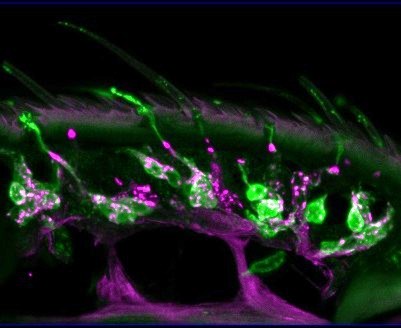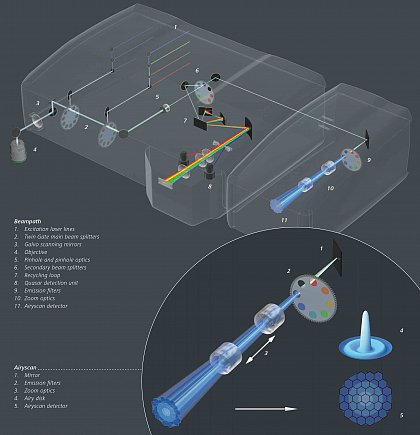
General Description
Generell characteristics
The LSM 880 is a fast and sensitive confocal microscope designed to give reliable quantitative data over the whole field of view.
Our system is equipped with a 32-channel GaAsP spectral detector that allows photon counting with high Quantum Efficiency. Two side PMTs complement this detection unit and expand the spectral working range allowing you to perform simultaneous 34-channel readout in lambda mode.
Many dyes (up to 10) can be acquired and separated at the same time. In the channel mode it is possible to image up to 13 frames per second, while in lambda mode you can acquire the entire spectrum in just one scan at 5 frames per second. The new GaAsP detectors, allow to get up to two times better Signal noise ratios for 2x faster acquisition.
In addition, the system has the revolutionary Airyscan detector which provides the fast superresolution and sensitive confocal image acquisition.
Airy scan principle
(text and picture adopted fom Carl Zeiss)
Airyscan is a detector that draws on the fact that In a fluorescence microscope will image a point-like source as an extended Airy disk (Airy pattern). In a standard confocal microscope the out-of-focus emission light is rejected at a pinhole, the size of which determines how much of the Airy pattern reaches the detector. In a standard confocal microscope, you get a sharper image by gradually closing the pinhole to reject out-of-focus light. However, it’s also dimmer since a great deal of light is then lost. The smaller the pinhole, the higher the resolution, but – equally – the greater the loss in light.
Airyscan solves this conundrum between resolution and light efficiency by imaging the Airy disk onto a concentrically-arranged hexagonal detector array. Its detection area consists of 32 single detector elements, all of which act like very small pinholes. The confocal pinhole itself remains open and doesn’t block light – thus all photons of the whole Airy disk are collected.
The signals from all detector elements are then reassigned to their correct position, producing an image with increased signal-to-noise ratio and resolution.

Beam path of the LSM 880 with Airyscan. First, emission light travels through the Twin Gate main dichroic beam splitter. The splitter allows for very efficient laser suppression to deliver supreme contrast.
Reaching the secondary beam splitter, all emission light is send either to an internal spectral detection unit (Quasar, with up to 34 channels) or alternatively, to the Airyscan detector with GaAsP technology




